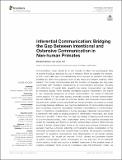Files in this item
Inferential communication : bridging the gap between intentional and ostensive communication in non-human primates
Item metadata
| dc.contributor.author | Warren, Elizabeth | |
| dc.contributor.author | Call, Josep | |
| dc.date.accessioned | 2022-02-02T12:30:12Z | |
| dc.date.available | 2022-02-02T12:30:12Z | |
| dc.date.issued | 2022-01-14 | |
| dc.identifier | 277693189 | |
| dc.identifier | 6b64b07a-3195-4f24-b16b-ba9a964c5005 | |
| dc.identifier | 85123785026 | |
| dc.identifier | 000752674400001 | |
| dc.identifier.citation | Warren , E & Call , J 2022 , ' Inferential communication : bridging the gap between intentional and ostensive communication in non-human primates ' , Frontiers in Psychology , vol. 12 , 718251 . https://doi.org/10.3389/fpsyg.2021.718251 | en |
| dc.identifier.issn | 1664-1078 | |
| dc.identifier.other | Jisc: e0f50391e9b444b5b6bcfa7d3bec3363 | |
| dc.identifier.other | ORCID: /0000-0002-8597-8336/work/107718265 | |
| dc.identifier.uri | https://hdl.handle.net/10023/24791 | |
| dc.description | Funding: This work was supported by the European Union’s Seventh Framework Programme (FP7/2007–2013)/ERC Grant 609819 (SOMICS). | en |
| dc.description.abstract | Communication, when defined as an act intended to affect the psychological state of another individual, demands the use of inference. Either the signaler, the recipient, or both must make leaps of understanding which surpass the semantic information available and draw from pragmatic clues to fully imbue and interpret meaning. While research into human communication and the evolution of language has long been comfortable with mentalistic interpretations of communicative exchanges, including rich attributions of mental state, research into animal communication has balked at theoretical models which describe mentalized cognitive mechanisms. We submit a new theoretical perspective on animal communication: the model of inferential communication. For use when existing proximate models of animal communication are not sufficient to fully explain the complex, flexible, and intentional communication documented in certain species, specifically non-human primates, we present our model as a bridge between shallower, less cognitive descriptions of communicative behavior and the perhaps otherwise inaccessible mentalistic interpretations of communication found in theoretical considerations of human language. Inferential communication is a framework that builds on existing evidence of referentiality, intentionality, and social inference in primates. It allows that they might be capable of applying social inferences to a communicative setting, which could explain some of the cognitive processes that enable the complexity and flexibility of primate communication systems. While historical models of animal communication focus on the means-ends process of behavior and apparent cognitive outcomes, inferential communication invites consideration of the mentalistic processes that must underlie those outcomes. We propose a mentalized approach to questions, investigations, and interpretations of non-human primate communication. We include an overview of both ultimate and proximate models of animal communication, which contextualize the role and utility of our inferential communication model, and provide a detailed breakdown of the possible levels of cognitive complexity which could be investigated using this framework. Finally, we present some possible applications of inferential communication in the field of non-human primate communication and highlight the role it could play in advancing progress toward an increasingly precise understanding of the cognitive capabilities of our closest living relatives. | |
| dc.format.extent | 17 | |
| dc.format.extent | 1952499 | |
| dc.language.iso | eng | |
| dc.relation.ispartof | Frontiers in Psychology | en |
| dc.subject | Animal communication | en |
| dc.subject | Primates | en |
| dc.subject | Social inference | en |
| dc.subject | Communication cognition | en |
| dc.subject | Intentionality | en |
| dc.subject | Inferential communication | en |
| dc.subject | Cognitive flexibility | en |
| dc.subject | Social cognition | en |
| dc.subject | BF Psychology | en |
| dc.subject | QL Zoology | en |
| dc.subject | T-NDAS | en |
| dc.subject | MCC | en |
| dc.subject.lcc | BF | en |
| dc.subject.lcc | QL | en |
| dc.title | Inferential communication : bridging the gap between intentional and ostensive communication in non-human primates | en |
| dc.type | Journal article | en |
| dc.contributor.sponsor | European Research Council | en |
| dc.contributor.institution | University of St Andrews. Organic Semiconductor Centre | en |
| dc.contributor.institution | University of St Andrews. School of Psychology and Neuroscience | en |
| dc.contributor.institution | University of St Andrews. Centre for Social Learning & Cognitive Evolution | en |
| dc.identifier.doi | 10.3389/fpsyg.2021.718251 | |
| dc.description.status | Peer reviewed | en |
| dc.identifier.grantnumber | 609819 | en |
This item appears in the following Collection(s)
Items in the St Andrews Research Repository are protected by copyright, with all rights reserved, unless otherwise indicated.

